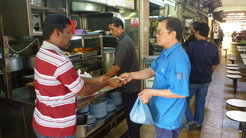Notes on the Familiar Stranger: thinking through ambivalent encounters in public spaces. Part One.
by Junjia Ye

Thursday evening 6.30pm at the post office in Jurong Point. Standing in line, I notice an Indian man clutching a white envelope. He is dressed in shirt and pants, a backpack on him. He looks rather confused as he looks at the different lines in the post office. It is crowded with different queues for different purposes (collecting packages, sending mail, paying bills…). He looks a bit unsure if he needs the line for “General Services” which is where he is already standing. At the same time, he is glancing at the line for “Remittances”. He asks a woman in front of him. She looks to be in her 50s, Chinese-Singaporean probably. She is in the middle of sneezing, yet holds it back when she realizes he is asking her for directions. She nods and points him to stay in his line – they do not exchange words. He looks a bit relieved. She turns away to sneeze in her hand but away from his direction. He apologises probably because he thinks he must have interrupted her sneeze. She turns back and gestures that it is ok and that she didn’t want to sneeze at him. This is all with the wave of hands and shake of heads. Their interaction ends there.
This excerpt from my fieldnotes points to much of the social encounters I observed during my fieldwork[1] in the pubic spaces of Singapore’s Jurong West, where the majority of people do not know one another personally. Broadly, the Familiar Stranger[2] is an open-ended notion that contributes to the growing interest in sociabilities in diverse settings. I use this term to bring into productive conversation the expanding work on social encounters and the literature on cosmopolitanism.
There is no space here to undertake a review of the literature on cosmopolitanism but at its core, writings on cosmopolitanism imply, if not celebrate, an openness towards diversity. At the same time however, cosmopolitanism, requires an on-going negotiation of daily cultural conditions to which we are not accustomed. Indeed, such a requirement precisely points to the “difficult, uneasy and radically incomplete effort of cosmopolitanism” (Fine and Boon, 2007: 6). I argue that much of coexistence in diverse spaces requires putting into practice ways of living in close proximity that can at once be tensed and positive, spontaneous and premeditated through larger processes. These forms of coexistence form the majority of everyday life that is led in close proximity with mostly personally unknown others but whom we have sufficient categorical knowledge, through our tools of social organization.

In this regard, I situate the familiar stranger by taking into account the limits of human recognition amidst the swirls of multiplicity in the city’s buses, parks, malls and markets while also recognizing the capacity of individuals in diverse settings to expand the sphere of possible identifications and social relations. It is, in short, a concept that enables an ambivalent reading of social encounters that can either be interactive or not. The Familiar Stranger describes the individuals that one meets in urban settings based on categorical knowledge without personal knowledge. The categorical knowledge we have of familiar strangers in our midst orients our interactions with them. This categorical knowledge is crucial in enabling the social interaction/exchange. For example, the Indian man likely presumed that the Chinese woman would be able to help him as he read her categorically as local and would hence probably be able to direct or at least read the instructions for him. She also figured that he may need some more general help, rather than simply remittances and so it might be most useful for him to stand in line for “General Services”. While there is a “script” involved in this sort of mundane exchange, the concept of the familiar stranger is more than a set of habitualized codes of conduct that enable social exchange (Goffman, 1971;). The significance of this term lies in its principle of living together without personal recognition and through this, emerges the element of ambivalence which underlie the majority of encounters one has in diverse urban settings. Indeed, the relationship we have with the Familiar Stranger is a form of sociality that carries with it a strong degree of ambivalence. Ambivalence can certainly include darker feelings of apprehension or disdain – indeed, perhaps, a geography of tension, as suggested by Valentine and Waite (2012). At the same time, it can also leak into geographies of possibilities precisely because this ambivalence can also carve out a different, more subtle space of relating to the other. The Familiar Stranger is not a meta-theory that prescribes how transient encounters can be “scaled up” (Valentine, 2008). It is a concept that hints at fragmented ways of relating to the other where people need not necessarily have intimate knowledge of or like the other in order for fleeting opportunities of civil, cooperative or hospitable interactions. Indeed, the nature of interactions does not mean that “everything has to be rosy: that sociality is not the same as liking” (Thrift, 2005: 139). The sociality of the Familiar Stranger carries with it an ambivalence that is arguably the by-product of living in cities, especially one that is diverse. Social connections that are possible among familiar strangers allow for a form of “civility of indifference, a skill of co-habitation without rancor” (Bailey, 1996).
These skills of cohabitation, in turn because part of an individual’s urban savvy which is activated more prominently during certain times. As Amin argues, there are various sorts of politics of living with the stranger which are situated within specific conditions (2012). There are “moments, situations and modes of encounter where people learn prosaic methods of accommodation ...” (Wise, 2013: 39). These forms of socialities challenge and/or facilitate people’s capacity to live with difference in different historical and geographical contexts and locations. The two individuals in the opening quote, for example, have acquired enough of intercultural know-how to not only accomplish the immediate task at hand (ie: pointing the man in the right line) but also, to approach the encounter with civility that is situated within those few minutes (he apologizes while she holds back her sneeze and eventually sneezing away from him). The woman likely also recognizes that this man does not speak Mandarin or English, hence relying on gestures even after her sneeze. In other words, she has sufficient familiarity in reading the stranger to realize that in order to provide directions effectively, gestures would be most efficient.

I am, however, cautious about reifying the encounter and while these are locally-based, these encounters are also constituted by experiences beyond the immediate situation. They do not exist in the abstract but are enacted and embedded with broader social processes and relations. Indeed, the politics of the Familiar Stranger can still hide within it injuries of class, gender, race, nationality. In other words, while this form of sociality can create encounters of civil inattention and restraint or more interactive encounters that allow for cooperation and help, it can also maintain social inequalities and hierarchies. The pre-reflexive reading of strangers for familiarity is oriented by not just by cumulative acquisition of habits or scripting, but also by the internalization of the social order. Thus, rather than a normative, romanticizing account of how people should relate to the other in public space, the familiar stranger enables us to consider the social processes and materialities situated elsewhere that are connected to a specific encounter. It questions the linkages with spaces outside of the encounter, allowing us to see the socio-spatial continuum that renders the encounter larger than its immediacy, filling a gap in much of the literature on social interactions. The very ambivalence of the before and after effects of the encounter is important: we don’t know if the woman at the post office harbours darker feelings of discrimination against the Indian man or not. We do not know if the Indian man is disgusted by her sneeze. They had no further communication beyond this encounter. In spite of this, the banal task of directing the Indian man to the right line was still accomplished.
In the forthcoming part two of my discussion of the familiar stranger, I shall be elaborating on encounters that are non-interactive. As ever, I invite your comments and critique on this concept that is a work-in-progress.
Footnotes
[1] This fieldwork was conducted as part of GLOBALDIVERCITIES, which is a larger, comparative project that includes Singapore, Johannesburg and New York.
[2] It has been used in the field of social psychology by Stanley Milgram (1972) but I wish to extend this term to include interactive modes of socialities in diverse settings.
References
Amin, A., (2012), Land of Strangers.
Bailey, F.G., (1996), The Civility of Indifference, Ithaca, NY: Princeton University Press.
Fine, R. and Boon, V., (2007), “Cosmopolitanism: Between Past and Future” in European Journal of Social Theory, Vol.10(5): 5-16.
Goffman, E., (1971), Relations in public: microstudies of the public order, Allen Lane, London.
Milgram, S., (1972), The Familiar Stranger: An Aspect of Urban Anonymity.
Thrift, N., (2005), “But malice aforethought: cities and the natural history of hatred” in Transactions of the Institute of British Geographers, Vol.30: 133-150.
Valentine, G. and Waite, L, (2012), “Negotiating Difference through Everyday Encounters: The Case of Sexual Orientation and Religion and Belief” in Antipode, Vol.44(2): 474-492.
Wise, A., (2013), “Hope in a Land of Strangers”, in Identities: Global Studies in Culture and Power, Vol.20(1): 37-45.


